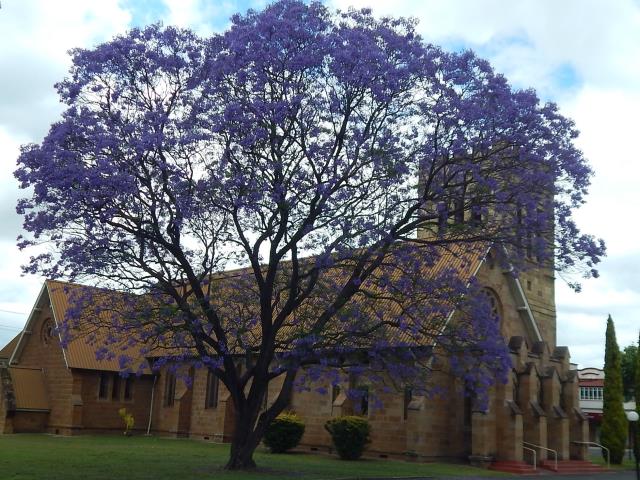By Bob Wilson
Local writer and journalist – and songwriter and musician – BOB WILSON shares his latest ‘Observations’ column.
On Remembrance Day (November 11), we met a Year 12 student who had been singing in our community choir but had taken time out to concentrate on her studies. She told us (with some excitement), that school was set to finish the following week. That reminded me of the old Queensland maxim about flowering jacarandas and exam times. The story goes that if the jacarandas are flowering and you are behind on your studies, it is too late!
That may have changed over the decades, as climate change has led to earlier flowering, not only of jacarandas, but cherry blossoms (more on that later).
When I visited Brisbane in late September, the jacarandas were already starting to bloom. They flower later across the Southern Downs, as we know, but even so, this old jacaranda in the grounds of St Mark’s Anglican Church (above) was starting to lose its blossoms as I took this photo on November 9.
Warwick has some lovely mature examples of this tree, many of them in the yards of private homes. In some towns and cities (Grafton, Toowoomba, Brisbane, Sydney’s north shore), jacarandas were planted on either side of city streets, to create a stunning, if ephemeral display from mid-October to mid-November.
Jacaranda is the name for a genus of 49 species of flowering plants in the family Bignoniaceae, native to tropical and subtropical regions of the Americas. Wikipedia describes it as a ‘cosmopolitan’ plant.
It is common across many continents and countries including Argentina, Botswana, Brazil, Florida, Israel, Italy, Mexico, Paraguay, Portugal, Saudi Arabia, South Africa, Southern California, Spain, Zambia and Zimbabwe. The jacaranda has been introduced to most tropical and subtropical regions and is widely planted in Asia.
Australian towns and cities compete for status of champion jacaranda; examples including Grafton, Brisbane, Toowoomba, Sydney, Melbourne and Perth (although not until December in WA).
Apart from the obvious connection with school and university exam times, the jacaranda’s purple haze is the first real sign of Spring.
When at their peak, the showy trees are hard to beat for a visual spectacle. Unfortunately, the triumph is short-lived; with storms, rain and wind soon littering the ground with purple flowers. As staff in hospital emergency rooms would attest, ‘slipped on wet jacaranda flowers’ is a common refrain when patients present at the fracture clinic.
Although I set out to write a ‘light and fluffy’ piece, it did not take much to uncover the climate science take on this. An article in The Conversation and republished in other journals similarly observed the early flowering of jacarandas in South Africa.
Jennifer Fitchett, Associate Professor of Physical Geography, University of the Witwatersrand, explained why early flowering of Jacaranda mimosifolia is a ‘warning sign’. Gauteng Province’s proliferating jacarandas have in recent years started flowering in early September. Octogenarian residents interviewed by researchers recalled the trees flowering in mid-November in the 1920s and 30s. The trees, native to Brazil, were introduced to Pretoria and Johannesburg in the late 1800s. Civic leaders of the time deemed them an ornamental worthy of lining streets in the suburbs and CBD.
Professor Fitchett wrote that jacaranda flowering had gradually advanced over the decades to mid-October and now to September. She described this process as ‘phenological shift’, which has been observed in multiple flowering tree species around the world. The earlier flowering is a key indicator that the planet is warming.
Prof Fitchett initiated the first known phenological shift study done in South Africa, singling out the jacaranda.
“Because jacaranda blossoms result in such a dramatic change in the urban landscape each year, they are often reported on in the news and, more recently, in social media posts,” she said.
“We mined these sources to compile a list of flowering dates of jacaranda trees spanning 1927-2019.”
These records allowed researchers to confirm the advance in flowering dates, quantifying a mean rate of advance of 2.1 days per decade.
The flowering took place against a backdrop of warming temperatures, ranging from 0.1-0.2°C per decade (daily maximums) and a more rapid 0.2-0.4°C per decade for daily minimums.
phys.org/news/2021-07-jacarandas-south-africa-earlier.html
Japan’s world-famous tourist attraction, cherry blossom season, has been under threat in 2020 and 2021. Covid restrictions meant that international tourists keen to witness the ‘sakura’ were unable to travel.. The data suggests the peak blooming date in Kyoto has been gradually moving from mid-April to the beginning of the month.
The Japanese have been studying phenological change for centuries, so they have a better handle on it than most. Cherry blossom flowerings last only a few weeks. They have been occurring earlier and earlier in recent decades.
The ABC reported in April this year that the famous cherry blossoms in Kyoto, Japan, peaked on March 26, the earliest date in 1,200 years, according to data compiled by Osaka University. Records that date back to 812 AD in imperial court documents and diaries show that the previous record was set in 1409, when the cherry blossom season reached its peak on March 27.
Kyoto experienced an unusually warm spring this season. The average temperature for March in Kyoto has climbed from 47.5 degrees Fahrenheit in 1953 to 51.1 degrees Fahrenheit in 2020. Japan’s national newspaper Mainichi reported that despite diminished human activity stemming from the COVID-19 pandemic, carbon dioxide levels in surrounding areas did not decrease.
abcnews.go.com/International/japans-cherry-blossoms-hit-earliest-peak-1200-years/story?id=76789632
As for the local jacarandas, go out into the suburbs with your camera or phone and capture those luscious jacaranda blossoms while they last. A handy illustration for those Christmas newsletters to family and friends.
Bob’s weekly blog Friday on My Mind can be found at www.bobwords.com.au







